More about Thimbles





Magdalena and William Isbister.
Equivocal thimbles
An equivocal thimble is one where the description allows the possibility of several different meanings, often with intent to deceive or misguide. The description may be susceptible to double interpretation and may be deliberately ambiguous. The thimble is not actually as described. Many such thimbles are offered on the Internet where the picture and description represent the only information about a particular thimble which is available to the would be buyer. It is not possible to detail every misrepresented thimble but we will show some examples. It should be remembered that a poor or inaccurate description may be to the advantage of the buyer and simply indicates ignorance on the part of the seller. More often it is the other way round and the buyer is misled into thinking a thimble is more significant than it really is. Not all sellers sell equivocal thimbles in order to cheat the buyer some sellers just do not know much about thimbles!
We have tried to categorise the main areas of misinformation found in relation to thimble descriptions and will try to demonstrate examples of each type. Clearly this cannot be a comprehensive review and readers are encouraged to search the TCI website mentioned above to see many more examples of thimbles which have been found to be ‘not as listed’.
Age
Thimbles are often stated to be older than they actually are. The words ‘antique’ and ‘vintage’ are frequently used to describe an advertised thimble. ‘Antique’ means over 100 years old but ‘vintage’ can mean anything and is a descriptive term which should be ignored.


Fig 76 Fig 77
This thimble (fig 76) was described as ‘Antique’ and ‘Fabergé’ but in fact the thimble and matching enamel étui (fig 77) is still being made by Russkiye Samotsvety in St Petersburg. The Factory was established by Czar Peter 1 in 1721, later it was the site of the jewellery firm of Carl Fabergé (Fabergé’s school).
Availability
Many thimbles are described as ‘rare’ although you only have to watch auction sites on the web to realise that the particular thimble often appears for sale. It is wise to be aware of what is happening on the auction sites in order to get a feel for the frequency with which items are listed. It may be helpful in relation to future purchases to keep a record of prices realised too.

Fig 78
This thimble (fig 78) is often said to be a ‘rare’ German thimble but it was made in ‘W. Germany’ in the eighties. The thimble is still for sale in sewing shops.
Damage
Sellers frequently use the terms good/excellent condition when close examination of the thimble may reveal obvious damage. It is wise before placing a bid to ask whether there has been any damage or repair to the thimble.
It is not necessary to even use a magnifier to see the holes in this thimble that was described to be in ‘very good condition’ (fig 79).

Fig 79
This thimble (fig 80) was said to be in ‘good condition’ but clearly a hand dimpled silver band has been applied to cover a row of holes at sometime during the thimble’s life. It was never made originally with this band.

Fig 80
This very damaged, holed top (fig 81) was hidden and repaired with a steel top but it can be seen that the rows of dimpling do not match up.
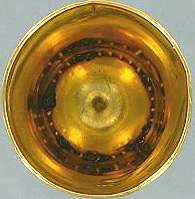
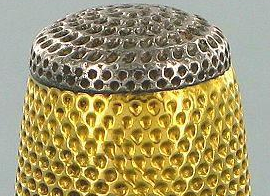
Fig 81
This thimble (fig 82) had a damaged top and was converted to a topless thimble. No topless thimbles of this type were ever made It was simply listed as a ‘rare’ thimble from the nineteenth century.

Fig 82

Fig 83
Originally this thimble (fig 83) would have had oval cabochon stones held in place by little claws. The original stones have been replaced by coloured stones held in place by glue leaving the original claws free!
Country of origin
Frequently thimbles are said to be from a particular country but often the country stated is incorrect. It is wise to check in reputable books about thimbles to see whether a particular thimble was ever made in the country suggested.
This thimble (fig 84) was said to be ‘Russian’ and made of ‘brass’. In fact, the thimble was made in Nürnberg and is made of silver.

Fig 84
Maker
Sellers often attribute thimbles to the wrong maker. Most probably this is a sign of unfamiliarity rather than a primary desire to deceive but it is important to check to see if a particular maker has ever made a similar thimble before?


Fig 85 Fig 86
The thimble of the left (fig 85) was described as having these markings - "S.F." (Samuel Foskett) with anchor, lion "E" (1879). The thimble was actually made by Shirley Frost in 1979. A similar thimble (fig 86) made by Ari D. Norman in 1990 is on the right.

Fig 87
This thimble (fig 87) was listed as a ‘David Anderson’ enamel thimble but in the top it was only marked ‘925s’. David Anderson would never have made such a thimble without stamping his own mark (a hammer overlying a pair of tongs) in the top as well as the stamps for silver fineness.
Material
Listings quite often mistake the material from which the thimble is made. Nickel silver is often mixed up with sterling silver and silver may be described as gold if it has become discoloured. You should ask whether the thimble has been tested if it is claimed that the thimble is gold and there is any doubt at all. Some thimbles were made in silver, silver gilt and rarely gold. Clearly the price to pay depends upon the material from which the thimble is made and you should try to research to see whether a particular thimble was ever made of gold for example. It is easy to mix up the French ‘boar’s head’ (Paris, 1838-) mark (fig 88) for silver, if the mark is upside down, with the ‘eagles head’ (Paris 1838-) mark (fig 89) for gold when the marks are rubbed and the silver is a bit tarnished.


Fig 88 Fig 89

Fig 90
This Charles Iles thimble (fig 90) was made in nickel silver in about 1890 – it was described as a ‘silver thimble’.
Thimbles may be described as ‘niello’ when the silver has just become so black that the tarnish will not easily clean off (fig 91).

Fig 91
Paint or nail varnish has been used to simulate enamel and it is wise to be aware of specific thimble designs and which thimbles may be ‘enamelled’.

Fig 92
This Stern Brothers thimble (fig 93) was never made with enamel panels and has clearly been painted.
Cloisonné is sometimes listed as antique enamel but cloisonné thimbles (fig 93) are neither rare nor old.

Fig 93
Hybridisation
Sometimes damaged thimbles are repaired by adding stones or undamaged pieces of other thimbles (4). This thimble had a damaged top so a stone was mounted over the holes (fig 94).

Fig 94
Stones are added to thimbles sometimes to enhance their appearance. There is no reason not to bid for such items but one should be aware that the thimble is not as it was made originally.


Fig 95 Fig 96
This thimble (fig 95) was made by Simons Bros.; the stones have been added at a later date. Originally the thimble would have had a plain border and rim.
A thimble (fig 96) listed as ‘1890's Sterling Silver Simons Bros. with Turquoise Stone’ was never originally made with the stone that was applied later.

Fig 97
This Norwegian enamel silver gilt thimble (fig 97) was never intended to have a set of applied blue cabochon stones – they have clearly been added later.
Incorrect identification of design
Sellers, usually not thimble specialists, sometimes do not know or recognise the image depicted on the thimble.


Fig 98 Fig 99
The thimble on the left was listed as ‘Windsor Castle’ where as it was actually an American thimble made by Ketcham and McDougall in 1880 and depicts Mediterranean Pavilions (fig 98). A Windsor Castle thimble is shown for comparison on the right (fig 99).
The ‘Wedding thimble’ (12) is another example of an incorrectly identified thimble (fig 100).
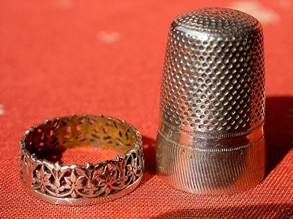

Fig 100
Not a thimble
From time to time ‘thimbles’ appear on web auctions which were never intended to be used for sewing so if you see something listed as a ‘thimble’ which does not look as though it could be used for pushing a needle (fig 101), wrong shape or too smooth for example, then beware!

Fig 101
Conclusion
Clearly it is not possible to detail and illustrate every ‘wrong’ thimble that is known to have appeared for auction. We have attempted to record examples of each type of thimble and hope that the reader will read further in order to increase their knowledge. In relation to the buying of thimbles on the internet and also in normal auctions there is no substitute for experience and this can only be gained by talking to experts and handling as many thimbles as you can. Eventually you will develop an instinct for knowing whether a thimble is ‘wrong’ or not (9).
Acknowledgements
We would like to thank Irene Schwall for permission to reproduce some of her images and Wolf-Dieter Scholz for help in identifying some of the thimble makers.
References
-
1.Holmes EF. A history of thimbles. London: Cornwall Books, 1985. pp. 220
-
2.Holmes EF. Thimble-RiggingThimble. Notes and Queries 1992; 15: 7.
-
3.Zalkin E. Zalkin’s Handbook of Thimbles & Sewing Implements, 1st ed. Willow Grove: Warman Publishing Co., Inc., 1985. pp. 243
-
4.Isbister M, Isbister W. Hybrid Thimbles. TCI Bulletin 2009; Winter: 1
-
5.Isbister M, Isbister W. Fabergé Thimbles. TCI Bulletin 2009; Summer: 1
-
6.Isbister M, Isbister W. Exposition Thimbles. TCI Bulletin 2010; Summer: 1
-
7.Plough G, et al. Hama, Fouilles et Recherches 1931- 1938 lV3. Copenhagen: Fondation Carlsberg, 1969. pp. 86.
-
8.von Hoelle JJ. Thimble collector’s encyclopedia. Illinois: Wallace-Homestead Book Company, 1986. pp. 134.
-
9.Zalkin E. Zalkin’s Handbook of Thimbles & Sewing Implements, 1st ed. Willow Grove: Warman Publishing Co., Inc., 1985. pp. 247, fig 31-8, fig 31-9, fig 31-10.
-
10.Belfford R. French Silver Thimbles. Silver, 1979: July-August: 34.
-
11.Isbister M, Isbister W. The ‘Merchants Warehouse’ Fable. TCI Bulletin 2007; Spring: 1
-
12.Isbister M, Isbister W. The wedding thimble – another myth?
https://docs.google.com/viewer?a=v&pid=sites&srcid=ZGVmYXVsdGRvbWFpbnxtb3JlYWJvdXR0aGltYmxlc3xneDo5M2YxNjhiNTQ4NmQ1NTE
Holmes: ‘Thimble Rigging’ pp. 220.
Addendum
June 2011
Recently the thimble on the left was listed as a 17th century tailor’s thimble but clearly the decoration ends abruptly at the top of the thimble because the rest of the thimble is missing. A proper English 17th century tailor’s thimble is shown for comparison. There are plain bands at both the top and the bottom of the thimble indicating that the thimble is complete.
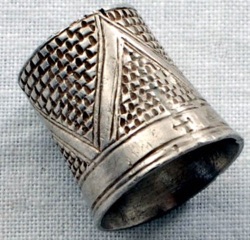

December 2011
Another type of 'not a thimble' originates from the decoration of a walking cane. Sometimes the silver or gold top is mistakenly described as a thimble. There is always a 'lower lip' to the thimble and usually a small hole will be found for securing the decorated metal top to the cane. This 9kt gold cane top was recently advertised as a thimble. It is fully hallmarked and assayed in 1905-6. It should not be confused as a thimble.
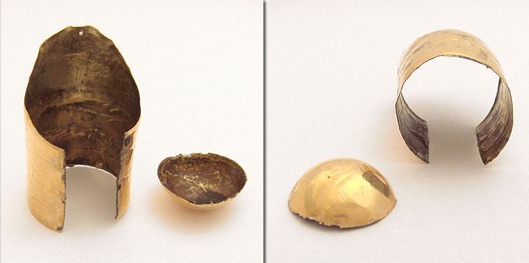
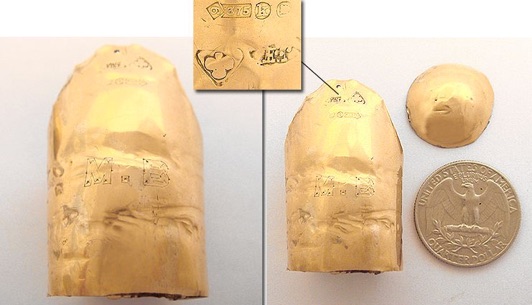
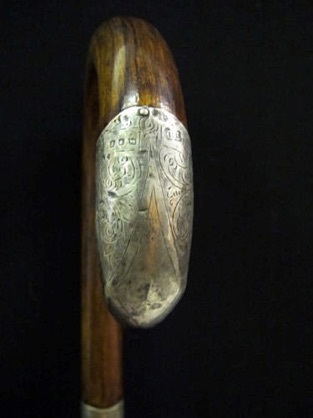
Silver walking stick 'thimble'
Recently we saw another American example of hybridisation. This Goldsmith Stern thimble has had a green stone panel (‘jade’ according to the seller) added following original manufacture to make it ‘more attractive’!
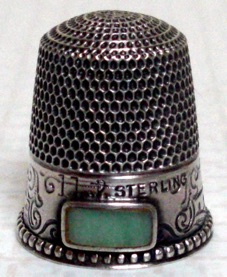
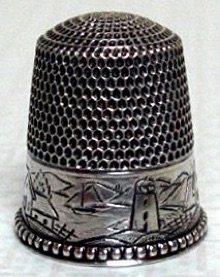
May 2012
Robert Carr of Sheffield made this copy of a late 19th century English silver thimble with a 'wiggle work' band above an applied galerie in 2006. The reproduction carries a laser printed hallmark and the galerie seems to have been die stamped. The original thimble is unmarked
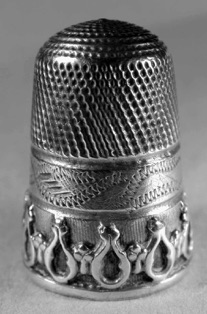
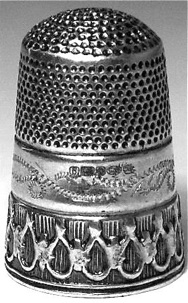
Original (left) and reproduction (right)

Laser mark: RC, 925, Sheffield rose, Lion Passant and date mark (2006)
September 2012
Recently a short piece that appeared in the TCI Bulletin in 1994 has come to light.
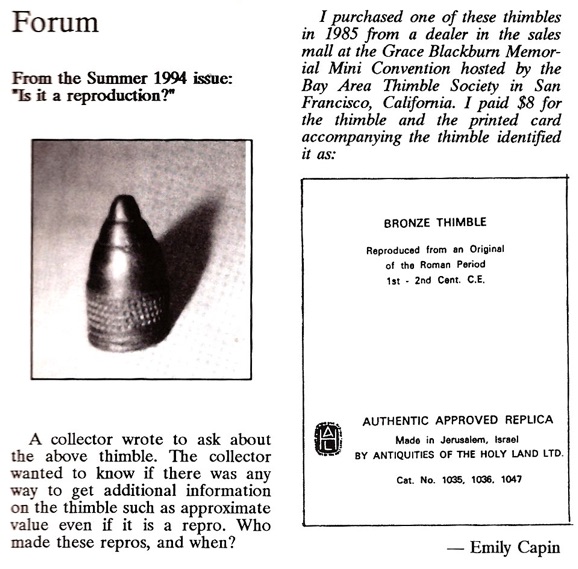
Although Capin undoubtedly bought this thimble in good faith, it is highly unlikely that the thimble and the accompanying 'printed card' originated together. The thimble is described, in the card as being 'reproduced from an original of the Roman period'. It seems very unlikely, even prior to 1994, that 'Antiquities of the Holy Land Ltd' would have mistaken an early Spanish-type thimble for a 'Roman' one and it is assumed that the printed card refers to another thimble and that the dealer either intentionally or unintentionally sold the card with the wrong thimble. The illustrated thimble is identical to thimbles made by Heirloom Editions Ltd. (see above).
Researched and published in 2002/11
Copyright@2011. All Rights Reserved
Magdalena and William Isbister, Moosbach, Germany
about ‘fakes’, reproductions and re-issues iii
Navigation
